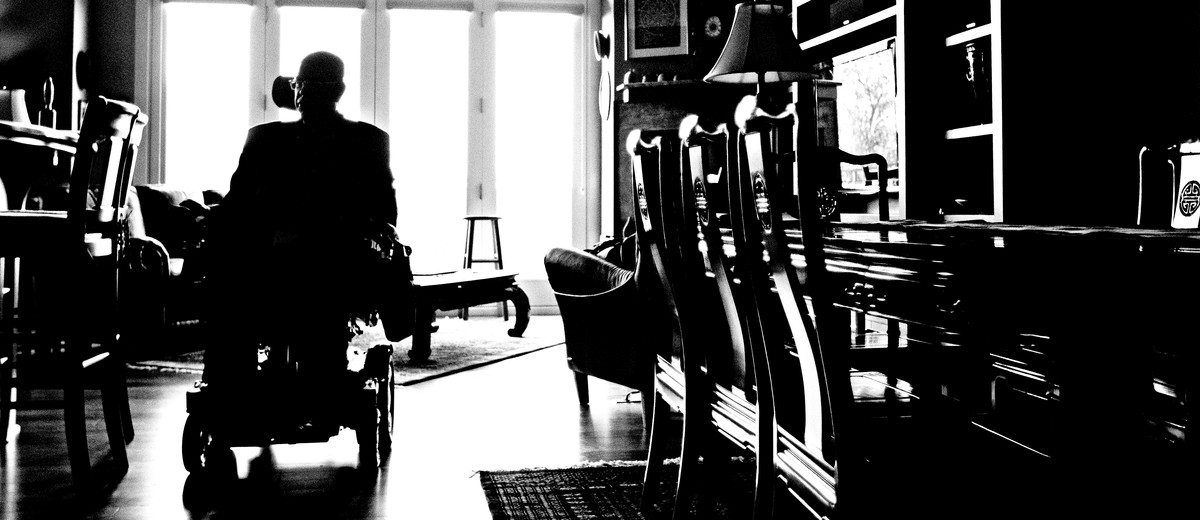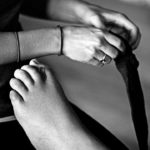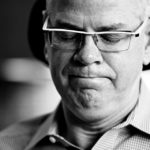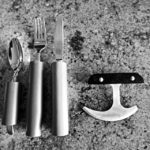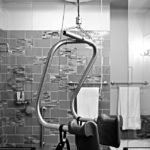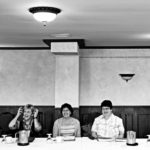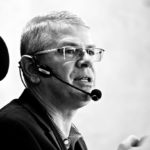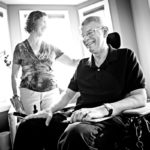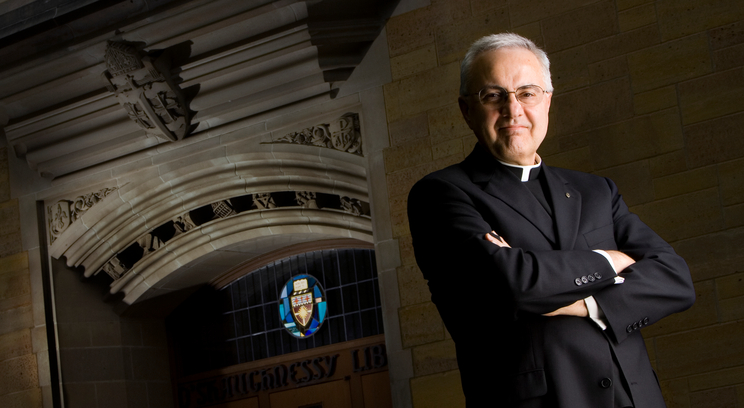Bruce Kramer always had been in excellent physical condition, and he was proud of it. He exercised regularly, was an avid bicyclist and survived on four hours of sleep as he juggled a busy schedule with his family, friends and job as dean of the College of Education, Leadership and Counseling at St. Thomas.
In the summer of 2010, he noticed he had a "floppy" left foot and thought it might be a pinched nerve or sciatica – not unusual for a bicyclist. During his regular physical examination, he mentioned he was "walking a little funny" and the doctor suggested he should see a neurologist. He procrastinated until he took a couple of falls in October, when his left leg collapsed.
Kramer saw a neurologist, "who pushed, pulled and hammered on me," conducted blood tests, scheduled an electromyogram and made an appointment to see him again Dec. 6, the day after the St. Thomas Christmas Concert at Orchestra Hall.
"I sat at the concert and I cried," he said. "I knew in my heart that the next day would bring bad news. And the music was so beautiful, it just touched my soul."
The neurologist was blunt with Kramer and his wife, Ev Emerson: "My diagnosis is that you have ALS (amyotrophic lateral sclerosis)," Kramer recalled him saying. "I was in there 20 minutes, and 19 were spent on me asking why he thought that."
Kramer went home and began to research ALS on the web. He got a second opinion, from the Mayo Clinic, and the diagnosis was the same. He began to share the news with family and friends, and he pondered what to do next.
"It all was very traumatic," he said.
The strong-willed Kramer wouldn't let trauma rule his life even though he knew ALS, also known as Lou Gehrig's Disease after the New York Yankees star, would lead to death.
So he planned his new life and moved forward. He began drug treatments, entered a drug trial and made quarterly visits to Mayo, where ALS clinic staff evaluated his status. He also began the Dis Ease Diary, a blog in which he shares news about his condition, teaches others about ALS and expresses emotions in remarkably candid terms.
"By focusing on Dis Ease, and the disease of ALS," he said, "it would be very easy for the reader to say, ‘Poor bastard, there but by the grace of God go I.’ Well, you’re there, too – you’re just not (dying) as quickly as I am. Maybe I can offer you some insights as I deal with these things."
He also wanted to make – and strengthen – connections.
"The idea here is that, even as the motor neurons come unconnected, the love, life, light and joy in all of us, even in the darkest times, becomes unified," he wrote in his first blog on March 2, 2011. "I admit this is very selfish, for I find that in the notes, letters, cards, and just chance meetings since my diagnosis, I am strengthened and energized for the days ahead. That is what love can do for us."
He has written more than 70 blog posts, and he admitted in June and July interviews that he finds it difficult to reread them because they remind him "what I was doing then that I’m not doing now. … I knew this when I started – that I would be documenting the loss – but I didn’t realize how hard it would be to go back and see the loss."
ALS is a progressive neurodegenerative disease affecting brain and spinal cord nerve cells that control voluntary muscle movement, and those cells die. Patients have difficulty breathing when chest muscles stop working and can become paralyzed. Most live two to five years after diagnosis.
Kramer’s physical condition has deteriorated gradually, from walking with a cane to moving around in a motorized wheelchair. He gave up driving in June, his legs have lost much of their strength and he no longer can button a shirt. He calls these losses "paper cuts" and describes ALS as "death by a thousand paper cuts."
"I traded in my manual transmission," he wrote in "The Automatic Paper Cut" on March 2, 2011. "A manual transmission requires two hands and two feet … (and) engagement with the road that says, ‘Put your feet on this ground and pay attention.’ … Automatic transmissions let you float above it all. They are mindless."
"Every single thing that I give up represents one more physical aspect that has become either impossible or close to impossible to do," he said. "It’s not like I was in an accident and had a severed spinal cord and that’s where I am now. You just see this thing coming, and there is nothing you can do about it."
As his body weakened, he also felt a sense of urgency – and passion.
"It isn’t enough to work," he wrote in "The Gift" on March 7, 2011. "It isn’t enough to love my family. It isn’t enough to connect with friends. It needs to be done with passion, abandon, love and light. There is no time to hold grudges, be afraid and not forgive. There is no time for games. There really are places to go, people to see and things to do, and time is wasting."
"Every day needs to count," said Ev, who teaches music at a K-5 French immersion school in Edina and has a master’s degree in music education from St. Thomas. "I remember getting kind of morbid and sad and Bruce smiling and saying, ‘Hey, I’m not dead yet.’"
The couple met at Indiana University, married in 1981 and have two sons with St. Thomas degrees: David (law) and Jon (bachelor’s in communication). Kramer taught high school music and directed choirs in Indiana before moving to Norway in 1983 to teach. The family later lived in Cairo, Egypt, and Bangkok, Thailand, where he was a school principal, before he joined the educational leadership faculty at St. Thomas in 1996.
Several months after his ALS diagnosis, they traveled to South Korea and then to Thailand and Bali to see family and friends. He began the 2011-12 academic year with a fuller realization of his condition as a result of his quarterly trips to Mayo’s ALS Clinic, where a test measures his physical skills on a scale of 0 to 48. At times, he is tempted to lie about a symptom.
"I know this is a delusion to maintain my own sense of control," he wrote in "Measuring Up" on May 2, 2011, "but it would allow me to say, ‘I am in charge of this person dammit, and y’all can go play your measurement games with some other patsy.’"
But, he admitted in an interview, he knows that is just an emotional reaction.
"I learned early on that the folks there are not asking questions because they want to nail you," he said. "In order to help you treat this, they have to have truthfulness, and so I found it behooves me to tell the truth, although once in a while I just would prefer not to! I know this is not a competition, but my score is in the low 30s now. I don’t like that. I don’t like losing."
Kramer has a huge support group as he deals with ALS, and front and center is his wife. He knew Ev would be there every step, but he worried in "The Sum of My Fears" blog on Aug. 31, 2011, about the impact on her and whether she had "any inkling of what was to come." This past summer, he could only marvel over her unconditional love and her resiliency.
"I have to admit I always thought I would be the one taking care of Ev – that I would be the one taking care of everybody," he said. "So now it gets flipped," and he wonders both what that will do to Ev and "what it will do to us. If you read enough about people and what ALS has done to their marriages, it’s turned them into not a partnership any more."
The partnership is there, and Ev believes it is stronger than ever.
"He’s my better half – my soul mate," she said. "I’m secure in my love for Bruce. People who never struggle miss out on the depth of a relationship. Certainly this illness changes the relationship, and you relate to each other in a different way than you’ve had to before."
Ev also has made her own adjustments by making sure she takes care of herself through exercise, meditation and allowing friends to help "so that I stay focused on the here and the now."
Kramer’s wry humor helps deal with the tension. He said he has become a "remarkable" listener because "I don’t have the strength to interrupt," and he is grateful that she has cheerfully taken over his longtime duties in the kitchen. She jokes that she could hardly boil water when they got married, but she’s becoming a better cook.
"I’m a good baker," she said. "My pies are pretty hard to beat."
ALS also didn’t rob Kramer of his spirit or his spontaneity. His physical falls both had bruised and scared him, and he reasoned that he needed "to take the dis eased meaning of ‘fall’ and reinvigorate it somehow," so he went skydiving in August and November last year.
"The experience of the skydiving itself was just, oh-my-gosh, just incredible," he said. "I don’t think I ever have experienced anything like that. The rush! But also the experience of preparation. This heavily tattooed guy took me both times, and told me more than once that this is why he lived – to get guys like me to jump out of an airplane."
The first jump freed him of earthly bonds and fear, but the second jump was more rewarding.
"I was able to really slow the experience down because I knew what was coming," he said. "What a lesson, to be able to be there. I still think about the second jump and that it actually lasted at least an hour. I know that’s not true, but that’s how it felt to me."
Kramer and his wife decided to sell their multilevel Minneapolis house and design a one-level condo in Hopkins to accommodate his needs. The sale was "another paper cut in a long line of paper cuts," he said, but the move last March went smoothly even as he struggled with basic day-to-day tasks.
"How do you go to the bathroom when the toilet is so low that you cannot get off it?" he asked in "The X Factor" blog on Oct. 3, 2011. "How do you eat when all you want to do is throw up? How do you shower, shave, put on deodorant when your hands shake so badly that you are afraid you will leave your face in ribbons? How do you get dressed when your legs and feet feel like alien beings stuck onto your body by a cruel prankster?"
Preparing for a workday takes patience, persistence and – above all – planning.
Kramer laughed that he used to "just leap out of bed," but it’s a more deliberative process today. The alarm goes off at 5 a.m., he takes his medications and gets up at 5:30. A home-care aide arrives at 7 to help him stretch, finish dressing and eat so he is out the door at 8 and in the office by 9.
"It’s so easy to stay here after 5," he said, looking around his Opus Hall office on the Minneapolis campus. "I go home and I fall asleep – just kick back in a chair and nap, and there may be things I feel I need to get done. I try to do computer work (at home) if I can. When fatigue hits, it hits and there’s nothing I can do about it."
Kramer will remain dean as long as he feels he is able to make a contribution. He became dean in 2008 after a dozen years as a professor, department chair and associate dean, and he believes changes in how he does his job have been to the college’s benefit.
"It used to be, when I first started, that people would say, ‘Let’s see what Bruce wants to do.’ Now it may take longer to find directions where to go, but when we do everybody is on board and they realize I’m not going to carry as much water. My job is to keep them on track, to keep them with the program, if you will – the mission and vision."
Kramer always reminds himself to be patient, but occasional "meltdowns" are not only inevitable but also necessary to survive.
"Every once in a while, I just find myself crying at the loss," he wrote in "If I’m Lyin’ I’m Dyin’ " on Oct. 23, 2011. "Every once in awhile, I can’t help but shake my fist at God and curse my dis ease and this path I am on. Believe me, I am no saint, and it would be dishonest to pretend."
"I can tell if it’s going to be a bad day the minute I wake up to take my meds," he said in an interview. "I just know. A lot of that has to do with fatigue, a lot with cumulative effects. By the time I hit Friday I’m really tired, and it’s more often than not the day I come apart is Saturday. I think it’s just cathartic. When I first started writing the blog, I was getting feedback on things like wisdom and centering, and all of that is true – I have a centered-ness about myself that I never had before. But it doesn’t preclude the fact that I’m pissed, and once in a while it’s just not fair."
"When he first had his meltdowns, I couldn’t handle that and I had a meltdown, too," Ev said, but she came to realize and appreciate "that all these changes have to be grieved. You can’t pretend they’re not happening."
One year after his diagnosis, Kramer’s "Happy Anniversary" blog thanked ALS for showing him how "to live right here and right now," and two weeks later in "What Would You Do" he wrote that dis ease has given him "gifts unlooked for, in love and hugs, tears and laughter. It has not been easy, but it has been entirely worth it." Does he still feel that way today?
"Yes," he replied. "There’s a lot of fear two minutes from now and a lot of grief two minutes ago. It’s really that close. … For me, as I have gotten older, time seems to go quicker. I don’t have a lot of time left, so I have really learned to consciously stay right where I am, and that slows it down almost to the point where I can stop it."
His New Year’s resolution last Jan. 1 was simple: to live a "just right life" as a good husband, father, dean and citizen. Has he been able to do that?
"There was a time when I was a real perfectionist," he said. "But it’s not very productive when your body is crashing, so what was the standard for me two months ago can’t be the standard today. I have to set parameters for myself, or else we’re back to grieving and fearing. So ‘just right’ is enough. It’s kind of hitting the sweet spot."
A week into 2012, however, Kramer found himself musing, "Just how long?" The real question, he concluded, was "How well?" and he still asks himself both questions today.
"One of the biggest challenges is to stay present but also to be plan-full," he said. "If I find I need something without having thought about it, it’s too late. It got ahead of me, and this thing keeps rolling. ‘Just how long’ is a way to be plan-full … is walking right up to the precipice of that discipline, and once in a while I kind of fall over it."
Engagement with others also helps him deal with issues.
"You never feel more alive than when you are with people," he said. "It’s kind of ironic because I was never an extrovert, but I just realized there’s this connection we all have. So my fear is really that I won’t be able to be engaged. … That’s a far worse fate than imminent death. We’re all going to die."
One way Kramer and his wife remain engaged is through their church – Good Samaritan United Methodist in Edina – and their love of music. An Easter Sunday tradition is to invite the congregation to join the choir in the loft to sing the "Hallelujah Chorus." This year, after moving close to the organ console on the main floor, the couple suddenly found themselves surrounded by choir members.
"I had no idea they were going to come down and join us, and it made it really hard to sing," Kramer said. "I found myself crying, it was so beautiful. I think it’s a sign of connection. It’s those connections that really define for me a good life."
As he approached May, Kramer worried about his physical stamina to make it through the final three weeks of the school year. He survived, and on May 13 he built a "Going the Distance" blog around the words in the W.P. Kinsella novel Shoeless Joe (and the movie "Field of Dreams").
"You have this presence, this ghost, that is with you 24 hours a day," he said, "and it tells you that everything you do could be the last thing that you do, and how do you want it to be? Then it’s a question of living that out. I don’t claim to be a saint, but I do feel like I am a lot better prepared for what I ought to be doing as a human being, and that’s kind of going the distance."
After commencement, he wrote about the "Footprints" (May 26, 2012) that graduates will make, but he isn’t sure of his own.
"I know what kind of footprint I want to have left," he said. "I have always been an educator. I realized I was an educator even before I was a teacher. I just had to grow into that. But in the process of being an educator, you find yourself coming into contact with people who are well-developed in certain ways, and in other ways they are searching through the same questions that all of us ask. I guess my hope is that my footprint, because we worked together, was a little more fruitful."
Editor’s note: Interviews between Hennes and Kramer were conducted over the course of two months in summer 2012. You can read Kramer’s Dis Ease Diary at https://diseasediary.wordpress.com.
Sidebar: Kramer Wants Meaningful Patient-Centered Care, Education
[wpcol_1half id="" class="" style=""]
When Bruce Kramer was diagnosed with amyotrophic lateral sclerosis he was shocked that there was so little practical information that he could use to make informed judgments about how to live the rest of his life.
Part of the problem, he quickly came to discover, was that the vast majority of resources was targeted on finding a cure for the disease – and not on how to respond to the physical, emotional, spiritual and informational needs of patients (PALS) and their caregivers (CALS).
Kramer decided to do something about it. He wants to improve disease education through a partnership between St. Thomas, the ALS Center of Excellence at Hennepin County Medical Center and other organizations dealing with degenerative diseases such as ALS.
He told about one ALS pamphlet that he shared with faculty colleague Deb DeMeester. The cover illustration was of a bird holding a worm above a nest with three baby birds.
"I showed it to Deb," Kramer said, "and I asked, ‘Who are the baby birds?’ "
And DeMeester recalls Kramer’s answer: "‘I am not a baby bird!’ It left the image of total dependence. That’s not how Bruce saw himself and not how we believe ALS patients should be seen. The goal of patient services should be quality of life, not dependence on a medical system."
Kramer, DeMeester and Dr. Ezgi Tiryaki, director of the ALS Center of Excellence, joined forces to develop resources – classes, websites and printed materials – to help ALS patients and their caregivers address quality-of-life issues.
"How do people make reasoned decisions so that they don’t feel like they are giving up on their lives?" Kramer said. "How do we create an educated population?"
[/wpcol_1half]
[wpcol_1half_end id="" class="" style=""]
As project director, DeMeester has a research team working to understand questions that PALS and CALS have as well as the resources available to them. They hope to develop an interactive web site with decision-making tools to assist families, and are seeking grants and individual donations.
"Our ultimate goal is to help families affected by ALS stay ahead of its symptoms, make decisions about care in timely ways, assist in setting personal goals and address additional needs identified through our research," DeMeester said.
For DeMeester, the project is personal, too. Kramer was one of her professors when she earned her doctorate in educational leadership in 2003, and she co-teaches the program’s Ethics and Leadership class with him. Her sister-in-law died of ALS in 2001.
"If someone as brilliant as Bruce can’t find the answers to his questions, what about the majority of the population with ALS?" she asked. "Our program can and will make a difference."
Tiryaki, as a medical doctor, sees great value in what Kramer and DeMeester want to provide.
"Bruce speaks a different language than I do," she said. "Having a multi-disciplinary approach is the best way to go. We will develop a very fruitful collaboration on new ways to deliver patient-centered care so it is meaningful."
You can find the study online at www.stthomas.edu/alsstudy.
[/wpcol_1half_end]
Read more from St. Thomas Magazine.
